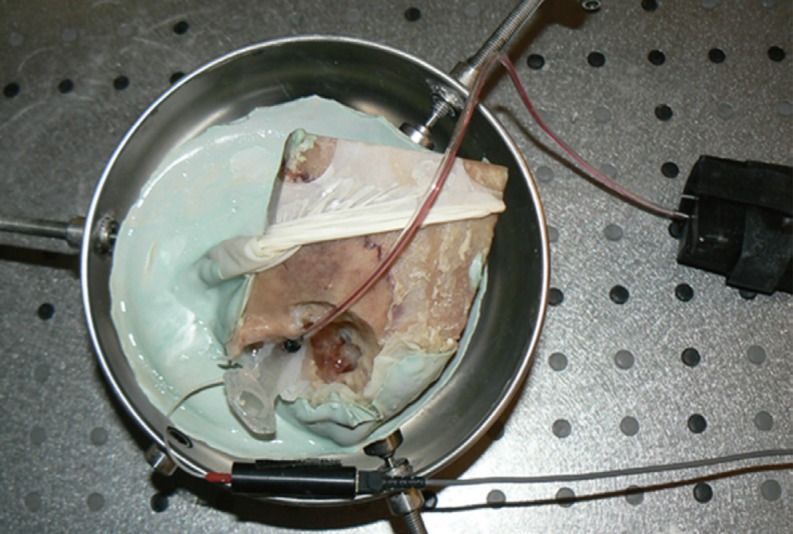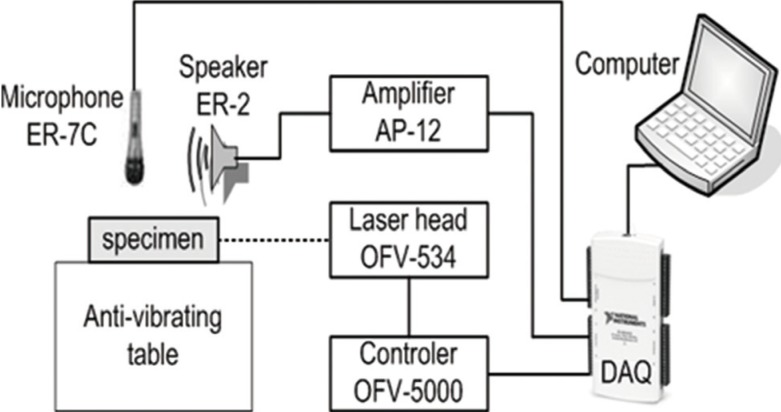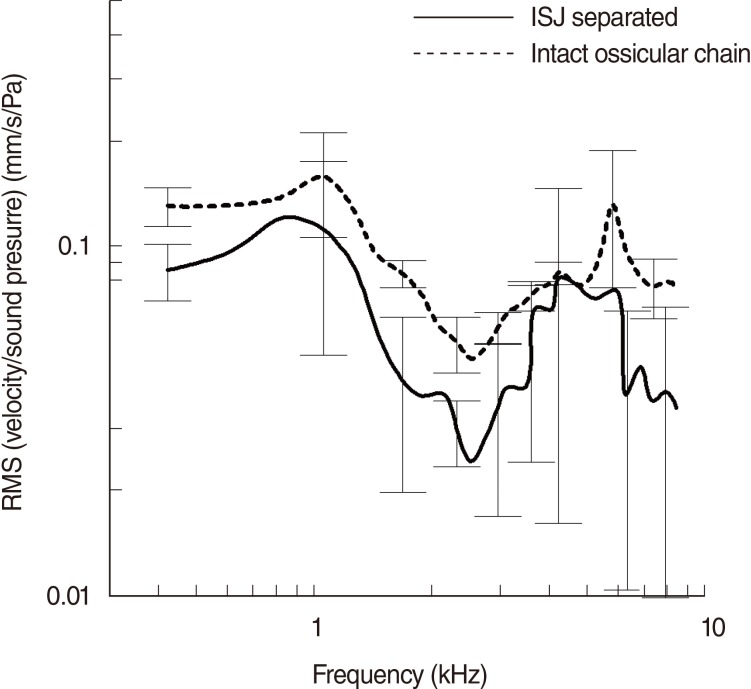Clin Exp Otorhinolaryngol.
2014 Dec;7(4):250-253. 10.3342/ceo.2014.7.4.250.
The Influence of Incudostapedial Joint Separation on the Middle Ear Transfer Function
- Affiliations
-
- 1Department of Otolaryngology-Head and Neck Surgery, Medical University of Lublin, Lublin, Poland. marcinszym@poczta.onet.pl
- 2Department of Applied Mechanics, Lublin University of Technology, Lublin, Poland.
- KMID: 2278362
- DOI: http://doi.org/10.3342/ceo.2014.7.4.250
Abstract
OBJECTIVES
One of the risks in middle ear surgery is high frequency hearing loss. It is believed that manipulations on the middle ear ossicles with the instruments may cause overstimulation of the inner ear and damage of the hear cells. Controversy arises whether temporary separation of the ossicles has any impact on middle ear transfer function and hearing threshold after surgery. The aim of the study is to evaluate the influence of incudostapedial joint (ISJ) separation on middle ear function in an experimental model.
METHODS
With the use of single point laser Doppler vibrometer (LDV) stapes velocity in the intact chain and after ISJ separation was measured in 5 fresh human cadaver temporal bones.
RESULTS
In all cases there was a decrease in stapes velocity after ISJ separation. Mead stapes velocity was reduced for 1 dB in 800 Hz to 9 dB in frequencies above 1,000 Hz. The decrease of velocity was greater in higher frequencies.
CONCLUSION
Separation of the ISJ does not reduce significantly the middle ear function.
MeSH Terms
Figure
Reference
-
1. Volter C, Baier G, Schon F, Muller J, Helms J. Inner ear depression after middle ear interventions. Laryngorhinootologie. 2000; 5. 79(5):260–265. PMID: 10911601.2. Tos M, Lau T, Plate S. Sensorineural hearing loss following chronic ear surgery. Ann Otol Rhinol Laryngol. 1984; Jul-Aug. 93(4 Pt 1):403–409. PMID: 6465785.
Article3. Desai AA, Aiyer RG, Pandya VK, Nair U. Postoperative sensorineural hearing loss after middle ear surgery. Indian J Otolaryngol Head Neck Surg. 2004; 7. 56(3):240–242. PMID: 23120088.4. Fisch U, May J, Linder T. Tympanoplasty, mastoidectomy, and stapes surgery. 2nd ed. New York, NY: Thieme;2008.5. Fisch U, Linder T. Microsurgery of the temporal bone: the Zurich dissection guidelines. 2nd ed. Tuttlingen, Germany: Endo-Press;2005.6. Fishman AJ, Marrinan MS, Huang TC, Kanowitz SJ. Total tympanic membrane reconstruction: AlloDerm versus temporalis fascia. Otolaryngol Head Neck Surg. 2005; 6. 132(6):906–915. PMID: 15944563.
Article7. Nadol JB, Schuknecht HF. Surgery of the ear and temporal bone. New York, NY: Raven Press;1993.8. Chien W, Northrop C, Levine S, Pilch BZ, Peake WT, Rosowski JJ, et al. Anatomy of the distal incus in humans. J Assoc Res Otolaryngol. 2009; 12. 10(4):485–496. PMID: 19685262.
Article9. Karmody CS, Northrop CC, Levine SR. The incudostapedial articulation: new concepts. Otol Neurotol. 2009; 10. 30(7):990–997. PMID: 19623094.10. Mills R, Szymanski M, Abel E. Movements of the intact and reconstructed ossicular chain during changes in static pressure. Acta Otolaryngol. 2004; 1. 124(1):26–29. PMID: 14977074.
Article11. Vlaming MS, Feenstra L. Studies on the mechanics of the normal human middle ear. Clin Otolaryngol Allied Sci. 1986; 10. 11(5):353–363. PMID: 3536194.
Article12. Mills R, Starriit N. Management of incus dislocation by physiological repositioning of the incus. J Laryngol Otol. 2002; 8. 116(8):589–592. PMID: 12389684.
Article13. Vishwakarma R, More YI, Joseph ST, Patel KB, Ramani MK, More RI. Incudostapedial joint arthroplasty using temporalis fascia/perichondrium ties. Am J Otolaryngol. 2009; May-Jun. 30(3):171–175. PMID: 19410122.
Article14. Nikolaidis V. Traumatic dislocation of the incudostapedial joint repaired with fibrin tissue adhesive. Laryngoscope. 2011; 3. 121(3):577–579. PMID: 21344438.
Article15. Kalcioglu MT, Tan M, Fleerakkers J. The use of bone cement for ossicular chain defects. Eur Arch Otorhinolaryngol. 2013; 11. 270(11):2849–2855. PMID: 23283240.
Article16. Jiang D, Bibas A, Santuli C, Donnelly N, Jeronimidis G, O'Connor AF. Equivalent noise level generated by drilling onto the ossicular chain as measured by laser Doppler vibrometry: a temporal bone study. Laryngoscope. 2007; 6. 117(6):1040–1045. PMID: 17545867.
Article17. Yin X, Stromberg AK, Duan M. Evaluation of the noise generated by ontological electrical drills and suction during cadaver surgery. Acta Otolaryngol. 2011; 11. 131(11):1132–1135. PMID: 21756022.
- Full Text Links
- Actions
-
Cited
- CITED
-
- Close
- Share
- Similar articles
-
- Mass and Stiffness Impact on the Middle Ear and the Cochlear Partition
- Histopathologic Study of the Guinea Pig Stapediovestibular Joint in Experimental Otitis Media
- An Experience of Surgical Management of Multiple Stapedial Crural Fracture
- Experience of Vascularized Joint Transfer for Segmental Loss of M-P Joint: A Case Report
- A Case of Incus Extrusion into the External Auditory Canal after Head Trauma




